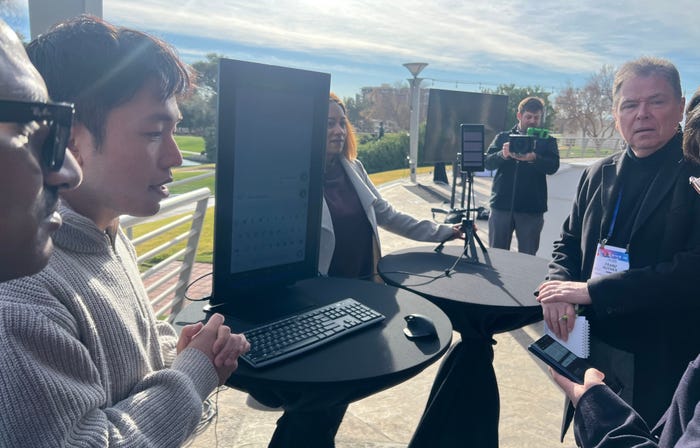California statewide deployment of NG911 ‘on hold’ pending project assessmentCalifornia statewide deployment of NG911 ‘on hold’ pending project assessment
An ambitious plan to transition all public-safety answering points (PSAPs) in the state of California from legacy 911 technology to an IP-based next-generation 911 (NG911) platform has been suspended for months amid safety and financial questions, as well as the “departure” of the longtime champion of the initiative, Walter “Budge” Currier.

An ambitious plan to transition all public-safety answering points (PSAPs) in the state of California from legacy 911 technology to an IP-based next-generation 911 (NG911) platform has been suspended for months amid safety and financial questions, as well as the “departure” of the longtime champion of the initiative, Walter “Budge” Currier.
Just a year ago, officials with the California Governor’s Office of Emergency Services (Cal OES)—the entity heading the NG911 transition effort—outlined a plan to the California State 911 Advisory Board that would result in all of the state’s approximately 440 PSAPs making the NG911 transition by the end of this year or early in 2025.
But Andrew Mattson, program management division chief for the Cal OES 911 branch, said only about 5% of California PSAPs were operating on systems leveraging the NG911 i3 standard established by the National Emergency Number Association.
“We have 22 PSAPs still live today taking i3 calls,” Mattson said during the California State 911 Advisory Board meeting conducted Wednesday. “We have 10 able to take transfers—our secondaries, our fire and EMS centers that are taking transfers from those 22 PSAPs.
“That number has not changed a lot this year. I think at the start of the year we had 18, so migrations have moved very slowly this year. And right now, we’re on hold, pending further analysis.”
Mattson provided some details about the suspension of the NG911 deployment effort, acknowledging that no new PSAPs have migrated to an NG911 platform during the past two months. During this time, several concerns about the state’s NG911 initiative have surfaced publicly, largely through recent reports by Candice Nguyen and other members of an NBC Bay Area team.
Mattson said Cal OES staff is in the process of re-evaluating the NG911 project.
“Right now, we’re doing a full network assessment,” Mattson said. “We have put all testing on hold. We have not migrated any PSAPs [recently]. At this point, our last wireless migration was Sept. 4. Testing has been put on hold since then. We have not migrated any PSAPs recently.”
A member of the 911 advisory board asked whether Cal OES staff could project when the massive effort to transition all California PSAPs from legacy technology to an NG911 platform.
Mattson responded: “Not at this moment—no. We’re working through our network analysis, and once we’ve made some determination of where the system stands and what our path forward needs to be, we will create new timelines and will have those ready for you shortly.”
After convening in closed session for more than an hour during the early portion of Wednesday’s meeting, the California State 911 Advisory Board decided it will conduct a special meeting prior to its regularly scheduled February 2025 meeting.
No date for the special meeting of the 911 advisory board was revealed, but it is being called “so that Cal OES may present and provide an analysis of any security impacts or implications related to recent concerns brought to 911 Advisory Board’s attention regarding the NG911 system and also for a presentation regarding the deployment status of the agencies currently receiving i3 direct calls,” according to legal counsel.
One key development during the past three months was the “recent departure” of Budge Currier, the former chairman of the California State 911 Advisory Board and the leader of the NG911 during the past decade. In December 2022, California Gov. Gavin Newsom appointed Currier as assistant director of public-safety communications at Cal OES.
While there had been some industry speculation since the summer that Currier might not be with Cal OES next year, there had been no public update about his status with the organization. Indeed, when NBC Bay Area reported last week that Currier and Cal OES parted ways in August, the news surprised California State 911 Advisory Board member Andrew White, who is the police chief for the city of Martinez.
White, who acted as chairman during Wednesday’s 911 advisory board meeting in the absence of Currier, said the NBC Bay Area reporting revealed problems with the NG911 rollout that he did not know existed. NBC Bay Area reported that a memorandum citing issues with the NG911 system was written in late 2022.
White expressed concern about this during the 911 advisory board meeting on Wednesday.
“Modernizing 911 is essential to meeting the evolving public-safety needs, but it can’t come at the expense of reliability or trust of the people who call 911 and the dispatchers who rely on the system to save lives,” White said. “Dispatchers need to know that concerns about the system will be heard and addressed promptly.
“We also must work to limit reoccurrences of issues as the system deployment progresses throughout the state. I’m certainly troubled by the lack of communication with the board regarding leadership changes impacting this project. I’m also concerned with information that has been brought forth to this point.
“However, I also understand that this is being looked into by Cal OES, and I think it’s important to give time for that to happen.
“If this board was misled in any way—whether intentionally, by negligence, poor communication or any combination thereof—that needs to come to light. It’s not about blame, but it’s about getting this project right. Action is what matters now.
Fellow 911 advisory board member Mark Chase—a business analyst for the Palo Alto Police Department and a member of the California National Emergency Number Association (CALNENA)—shared similar sentiments.
“As working 911 dispatchers, our greatest concern is to be able to assist those in need professionally and in a timely manner,” Chase said. “As a dispatcher, the reports of multiple agencies joining the same 911 or calls dropping are upsetting and stress-inducing. It also results in a delayed response. The public should not be subject to the technical failures of this project, and we should be doing everything we can, in the short term, to minimize these disruptions. The public’s safety cannot be compromised.
“That being said, we re-emphasize our belief that next-generation 911 must be implemented in California and across the nation. California urgently needs the benefits that moving to next-gen 911 will deliver. The current 1970s infrastructure that underpins our existing call-processing system is aging and unreliable.”
Chase also expressed the opinion that state officials underestimated the difficulties associated with making a statewide transition from legacy 911 technology to IP-based NG911 platforms.
“At the beginning of this project, an incorrect premise was made that next-gen 911 was going to be an easy project to scale and that once a few regional centers were up and running on the network, then it would be a natural transition to bring up other centers in the region, with few issues,” Chase said.
“At this time, we must admit to ourselves that there were unanticipated or unaccounted factors, but this is not a reason to stop pressing forward. California needs next-generation 911. CALNENA encourages the Cal OES [911] branch to reset realistic expectations and timelines, commit to transparency and engage with willing partners who seem ready to help.”
California’s NG911 deployment is being monitored by 911 officials throughout the U.S., as many hoped that the Cal OES initiative could demonstrate to others how NG911 could be deployed efficiently and effectively in all of the more than 6,000 PSAPs in the country. In addition, some public-safety advocates believed that a strong NG911 deployment in California could help justify an infusion of $10-$20 billion in federal funding to pay for a nationwide effort.
Instead, California has spent more than $400 million on its NG911 project and has transitioned only 22 PSAPs—only three more than the number Currier noted during his presentation on the matter during the IWCE 2024 event in March. This pace is very different from the deployment pace Currier shared with Urgent Communications in March 2021, when he projected that NG911 would be deployed statewide in California by the end of 2021 or early in 2022.
During that same IWCE session, Christy Williams—director of the North Central Texas Emergency Communications District (NCT9-1-1) that serves more than 40 PSAPs—also chronicled her organization’s struggles to deploy NG911, including the need to terminate its next-generation core services (NGCS) contract in February.





